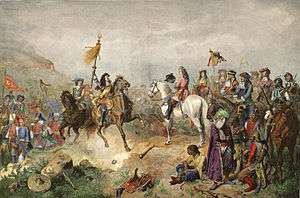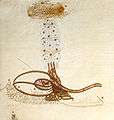Suleiman II
| Suleiman II سليمان ثانى | |||||
|---|---|---|---|---|---|
|
Sultan of the Ottoman Empire Kayser-i Rûm Custodian of the Two Holy Mosques Caliph of Islam | |||||
 | |||||
| 20th Ottoman Sultan (Emperor) | |||||
| Reign | 8 November 1687 – 22 June 1691 | ||||
| Predecessor | Mehmed IV | ||||
| Successor | Ahmed II | ||||
| Born |
15 April 1642 Topkapı Palace, Constantinople, Ottoman Empire | ||||
| Died |
22 or 23 June 1691 (aged 49) Edirne Palace, Edirne, Ottoman Empire | ||||
| Burial | Süleymaniye Mosque, Istanbul | ||||
| Consorts |
Hatice Kadın[1] Behzad Kadın[1] İvaz Kadın[1] Süğlün Kadın[1] Şehsuvar Kadın[1] Zeyneb Kadın[1] | ||||
| |||||
| Dynasty | Ottoman | ||||
| Father | Ibrahim | ||||
| Mother | Aşub Sultan | ||||
| Religion | Sunni Islam | ||||
| Tughra |
| ||||
Suleiman II (15 April 1642 – 22/23 June 1691) (Ottoman Turkish: سليمان ثانى Süleymān-i sānī) was the Sultan of the Ottoman Empire from 1687 to 1691. After being brought to the throne by an armed mutiny, Suleiman and his grand vizier Fazıl Mustafa Pasha were successfully able to turn the tide of the War of the Holy League, reconquering Belgrade in 1690, as well as carrying out significant fiscal and military reforms.
Early life
Suleiman II was born on 15 April 1642 at Topkapı Palace in Constantinople, the son of Sultan Ibrahim and Aşub Sultan, a Serb woman originally named Katarina.[2][3][4] Suleiman was only 3 months younger than his half-brother Mehmed IV, who was born on 2 January 1642. After the deposition and execution of his father in 1648, Suleiman's half-brother Mehmed came to the throne. In 1651, Suleiman was confined in kafes (cage), a kind of luxurious prison for princes of the blood within the Topkapı Palace (it was designed to ensure that none could organize a rebellion), and he stayed there for 36 years until he took the throne in 1687.
Reign
Ottoman–Habsburg War

Shortly before assuming the throne, the Ottomans suffered a devastating defeat at the second Battle of Mohács. Suleiman II shrewdly appointed Köprülü Fazıl Mustafa Pasha as his Grand Vizier, leading to the reconquest of Belgrade in 1690. Even so, when Russia joined an alliance of European powers, the Ottomans lost the support of their Crimean allies, who were forced to defend themselves from Russian invasion.
Under Köprülü's leadership the Ottomans halted an Austrian advance into Serbia and crushed an uprising in Macedonia and Bulgaria until Köprülü Fazıl Mustafa Pasha was killed in the Battle of Slankamen by Austrian forces. Suleiman II died at Edirne Palace in 1691.
Relations with the Mughal Empire
In 1688 the Ottoman Sultan Suleiman II urgently requested for assistance against the rapidly advancing Austrians, during the Ottoman–Habsburg War however the Mughal Emperor Aurangzeb and his forces were too heavily engaged in the Deccan Wars against the Marathas to commit any formal assistance to their desperate Ottoman allies.[5]
Gallery
 Tughra of Suleiman II
Tughra of Suleiman II Suleiman II in Croatia
Suleiman II in Croatia- Coin of Suleiman II
 Suleiman II
Suleiman II Suleiman II
Suleiman II
See also
Sources
- 1 2 3 4 5 6 M. Çağatay Uluçay, Padişahların Kadınları ve Kızları, Ötüken Publications, p. 113.
- ↑ "Sultan II. Süleyman Han". Republic of Turkey Ministry of Culture and Tourism. Retrieved 2009-02-06.
- ↑ Günseli İnal; Semiramis Arşivi (2005). Semiramis: Sultan'ın gözünden şenlik. YKY. p. 27. ISBN 978-975-08-0928-6.
Siileyman'in annesi Sirp Katrin yani Dilasiip Hatun
- ↑ Ali Kemal Meram (1977). Padişah anaları: resimli belgesel tarih romanı. Öz Yayınları. p. 325.
- ↑ Mughal-Ottoman relations: a study of political & diplomatic relations ... - Naimur Rahman Farooqi - Google Boeken. Books.google.com. 1989. Retrieved 29 April 2012.
External links
![]() Media related to Suleiman II at Wikimedia Commons
Media related to Suleiman II at Wikimedia Commons
| Suleiman II Born: 15 April 1642 Died: 22 June 1691[aged 49] | ||
| Regnal titles | ||
|---|---|---|
| Preceded by Mehmed IV |
Sultan of the Ottoman Empire 8 November 1687 – 22 June 1691 |
Succeeded by Ahmed II |
| Sunni Islam titles | ||
| Preceded by Mehmed IV |
Caliph of Islam 8 November 1687 – 22 June 1691 |
Succeeded by Ahmed II |
